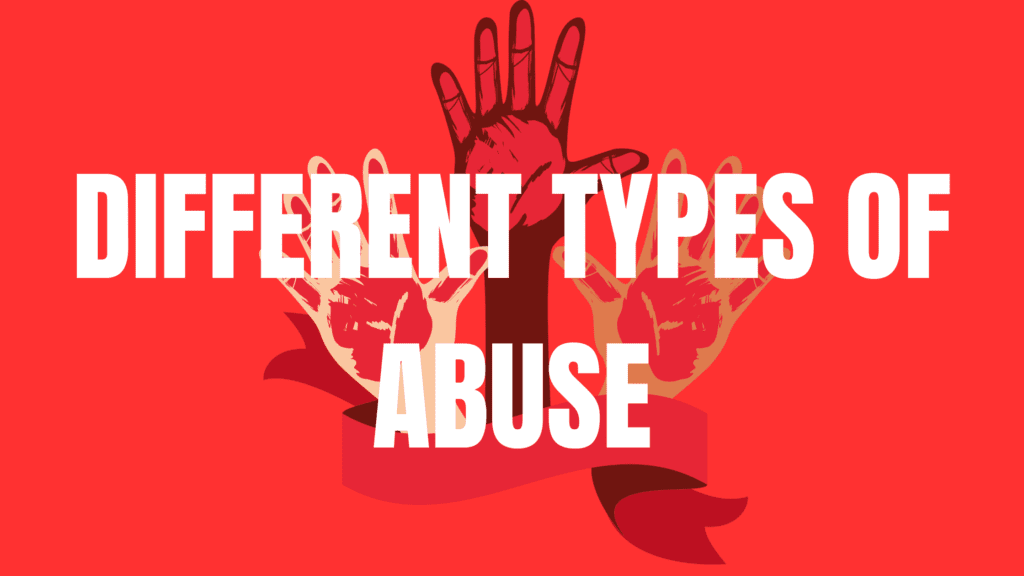Abuse is a complex and deeply troubling issue that affects millions of people across the globe. It transcends boundaries of age, gender, socioeconomic status, and culture. Understanding the different types of abuse is crucial to recognizing harmful behaviors, supporting victims, and working toward prevention. This comprehensive guide delves into the various forms of abuse, their warning signs, and ways to address them effectively.
1. Physical Abuse
Physical abuse involves the intentional use of physical force that results in injury, harm, or trauma. It can include hitting, slapping, kicking, choking, or any other act that causes physical pain or injury.
Signs of Physical Abuse:
- Unexplained bruises, cuts, or burns.
- Frequent injuries with vague or inconsistent explanations.
- Fearfulness or flinching when approached.
Impact: Physical abuse can lead to long-term physical disabilities, emotional trauma, and even death. Victims often struggle with chronic pain, anxiety, and trust issues.
2. Emotional Abuse
Emotional abuse, also known as psychological abuse, is a pattern of behavior that undermines a person’s self-esteem, confidence, and mental well-being. It often accompanies other forms of abuse.
Examples:
- Verbal insults, belittling, or constant criticism.
- Manipulation, gaslighting, or controlling behavior.
- Isolation from friends and family.
Signs of Emotional Abuse:
- Low self-esteem or self-worth.
- Anxiety, depression, or mood swings.
- Fear of making decisions or speaking out.
Impact: The scars of emotional abuse can be invisible but profound, often leading to long-term mental health challenges such as PTSD, anxiety, and depression.
3. Sexual Abuse
Sexual abuse involves any non-consensual sexual activity or behavior. This includes rape, molestation, unwanted touching, or coercion into sexual acts.
Signs of Sexual Abuse:
- Difficulty walking or sitting.
- Avoidance of specific people or places.
- Changes in behavior, such as withdrawal or aggression.
Impact: Sexual abuse can lead to severe emotional and psychological trauma, including feelings of shame, guilt, and fear. Survivors often experience difficulties in forming healthy relationships.
4. Financial Abuse
Financial abuse involves controlling or misusing another person’s financial resources without their consent. It is common in domestic violence situations and elder abuse cases.
Examples:
- Restricting access to money or financial information.
- Stealing or misusing funds.
- Forcing someone to sign financial documents under duress.
Signs of Financial Abuse:
- Sudden financial difficulties or unexplained withdrawals.
- Lack of access to personal financial records.
- Fear or reluctance to discuss finances.
Impact: Financial abuse can leave victims vulnerable to poverty, homelessness, and a lack of independence.
5. Neglect
Neglect is the failure to provide necessary care, assistance, or supervision to someone who depends on others for their well-being. It often affects children, the elderly, and individuals with disabilities.
Examples:
- Failing to provide food, shelter, or medical care.
- Ignoring emotional needs.
- Leaving someone alone in unsafe conditions.
Signs of Neglect:
- Malnutrition, poor hygiene, or untreated medical issues.
- Living in unsafe or unsanitary conditions.
- Withdrawal or developmental delays in children.
Impact: Neglect can lead to severe physical and emotional harm, developmental issues, and even death in extreme cases.
6. Digital Abuse
With the rise of technology, digital abuse has become increasingly prevalent. This involves using technology to harass, stalk, or intimidate someone.
Examples:
- Sending threatening or degrading messages.
- Cyberstalking or hacking into personal accounts.
- Sharing private photos or information without consent.
Signs of Digital Abuse:
- Anxiety around using phones or social media.
- Excessive monitoring by a partner or family member.
- Fear of being tracked or watched online.
Impact: Digital abuse can lead to emotional distress, loss of privacy, and in severe cases, physical harm if online threats escalate.
7. Cultural or Identity Abuse
This type of abuse targets a person’s cultural background, religion, ethnicity, or identity. It often involves discrimination, coercion, or ridicule.
Examples:
- Forcing someone to reject their cultural practices or beliefs.
- Using racial slurs or derogatory remarks.
- Isolating someone from their cultural community.
Impact: Cultural or identity abuse can lead to feelings of isolation, loss of identity, and deep emotional trauma.
8. Institutional Abuse
Institutional abuse occurs within systems or organizations where there is a power imbalance, such as care homes, schools, or workplaces.
Examples:
- Neglect or mistreatment in care facilities.
- Workplace harassment or exploitation.
- Abusive practices in schools or religious institutions.
Impact: Institutional abuse can erode trust in systems meant to provide support and lead to significant emotional and psychological harm.
How to Address Abuse
Recognizing abuse is the first step toward addressing it. Here are some ways to take action:
- Educate Yourself and Others: Understanding the signs and forms of abuse can help in identifying and preventing it.
- Provide Support: Listen to victims without judgment and encourage them to seek professional help.
- Contact Authorities: In cases of immediate danger, contact local authorities or emergency services.
- Access Resources: Many organizations offer support for victims, including hotlines, shelters, and counseling services.
- Advocate for Change: Promote policies and practices that prevent abuse and support survivors.
Conclusion
Abuse is a multifaceted issue with far-reaching consequences. By understanding the different types of abuse and their impact, we can create a safer, more supportive environment for everyone. Whether you are a survivor, a supporter, or simply an advocate for change, every effort counts in breaking the cycle of different types of abuse and fostering a culture of respect and empathy.

